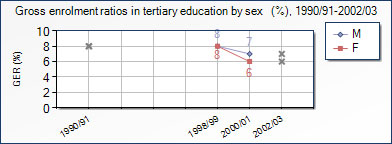Pocket statistics: Tertiary Education in Samoa
Contents
Overview of the Tertiary Education System in Samoa
The country has a population of approximately 176 000 people with 77% reported to reside in rural areas and 40% of the population between 0 and 14 years of age. Trend statistics for the last decade are not available.
Tertiary Gross Enrolment Ratio Statistics
| 1990/91 | 1998/99 | 2000/01 | 2002/03 | VUSSC Average | |
| MF Total | - | 8% | 7% | - | - |
| Male | - | 8% | 7% | - | - |
| Female | - | 8% | 6% | - | - |
There are XX government funded tertiary education institutions in the country providing learning opportunities for XX students. A strategic priority for Samoa's tertiary system is ...... Say something about ICT infrastructure and opportunities and challenges for elearning.
Government funded Tertiary Education Institutions
The National University of Samoa (Apia)
| Name of Institution | The National University Of Samoa |
| Website | http://www.nus.edu.ws/ |
| Type of Institution | The National University of Samoa merged with Samoa Polytechnic on March 08, 2006 to form the new National University of Samoa (2006). The National University includes the Institute of Higher Education (Faculties of Arts, Commerce, Education, Nursing and Health Sciences and Science), the Institute of Technology (formerly Samoa Polytechnic which includes the Schools of Engineering, Business and General Studies, and Maritime), the Centre for Samoan Studies, the Centre for Professional Studies and Continuing Education and a centralized administration for the library, student services, ICT, finance, and human resources. |
| Main mode of delivery | Campus based with minimal distance mode |
| Number of students | 2,298 (2006 enrolments) |
| Learning Management System(s) | Moodle |
| Overview of e-learning |
Minimal but in progress with school nets currently becoming established and priority plans for establishment of open and distance learning (ODL) unit for National University of Samoa. (There is currently an e-learning initiative with secondary schools through out Samoa called schools net which is in its early stages). The National University of Samoa offers e-learning through virtual classrooms. Below is a link which provides students and lecturers this mode of delivery which is across disciplines http://www.nus.edu.ws/virtualclassroom/index.php. The National University was also involved with the Advanced Lecture Series in International Environmental Studies (Asia Pacific Initiative for Sustainable Development) which used e-learning and included mixed technology of website, video conferencing and virtual classrooms for lecturers and participants. The following tertiary institutions were also involved in the pilot scheme that is now set to continue: • The United Nations University, Tokyo, Japan • Ryukus University, Okinawa, Japan • Keio University, Tokyo, Japan • The Asia Institute of Technology, Bangkok, Thailand • The University of Hawaii, Honolulu, USA • The University of the South Pacific, Suva, Fiji The Dean of Science of the National University of Samoa is a Senior Lecturer in Computing and an expert in e-learning in Samoa. Her doctoral research is based on e-learning using the case study of the National University of Samoa. Her research explores the teaching of java using the cable model and evaluating the effectiveness of on line learning in the virtual classroom. |
| If possible - the aggregate income composition of tertiary education institutions between: Government grant, tuition fees, research & consulting income expressed as a percentage of total income. | Total 2005 revenue: ST$7,549,599
(Inclusive of: Government Grant ST$5,000,000 (66.29%) Course fees ST$2,114,290 (28.01%) Consultany & research ST$ 41,196 ( 0.55%) (Source: NUS Audited Financial Statements For the Year Ended 30 June 2005 ) |
Name of institution (City)
| Name of Institution | Enter name here |
| Website | Eg http://www.col.org |
| Type of Institution | Eg. University, Polytechnic, Community College etc |
| Main mode of delivery | Eg. Campus-based, Single mode DE, Mixed Mode etc. |
| Number of students | State number of students and year here, eg 13 547 (2004 fugures) |
| Learning Management System(s) | For example ATutor, Moodle, KewlNextGen, Blackboard, WebCT etc. |
| Overview of e-learning | Enter brief description of e-learning activities at the institution |

